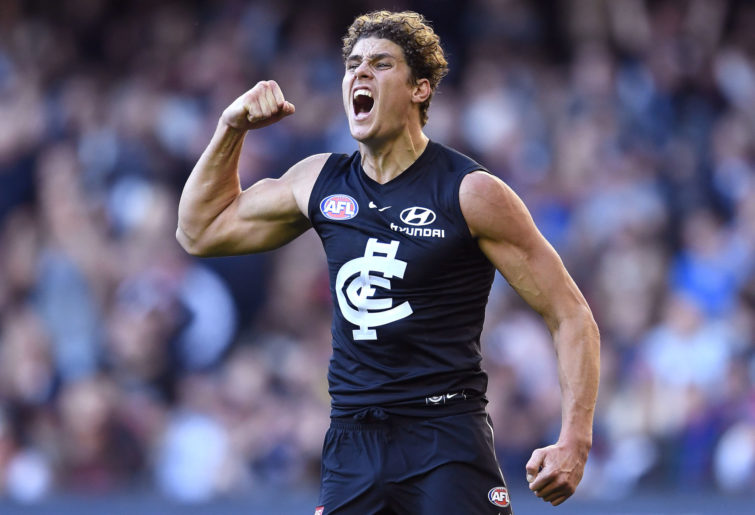It’ll come as no surprise that a club which has hit the draft as hard as Carlton has a younger list than most. They’ve got 30 players under 23 on their list – seven more than the league average, and the most of any club.
The league average expectation is to get 59 AFLCA votes from this group of players, and Carlton have 81 – the fourth most of any club, behind the Western Bulldogs, GWS, and Sydney. The kids are alright.
With Ed Curnow, Marc Murphy, Kade Simpson, Dale Thomas and Matthew Kreuzer the club actually has a pretty decent veteran group, especially for one so young.
But the prime age group is severely lacking, reflecting an era of sparse drafting success. The Blues have five less prime-age players than the average list and 70 less AFLCA votes from this group, take out Patrick Cripps and they’d have almost none.
| Carlton Blues list profile |
| Age |
Players |
Games |
% of total |
Votes |
% of total |
| 18-22 |
30 |
229 |
49.57% |
81 |
31.64% |
| 23-27 |
11 |
123 |
26.62% |
112 |
43.75% |
| 28+ |
7 |
110 |
23.81% |
63 |
24.61% |
| Total |
48 |
462 |
100.00% |
256 |
100.00% |
Under or over?
Carlton were 15th for average experience and 14th for average games played this year, reflecting a list that has a heavy skew towards youth.
They were the more experienced side than their opponents in nine games this year, but on five of these occasions, the gap was marginal. When it wasn’t marginal, Carlton won three of four matches, which is on par with expectation.
They struggled to win games when they were less experienced than their opponents, with just two wins from 12 occasions – arguably their best two wins of the season, against Brisbane and Adelaide.
The Blues finished sixth in the league for EUR, using about 70 per cent of their list experience each week. Obviously, they don’t have nearly as much of it to draw on as some other clubs.
Verdict: About even. The Blues finished roughly on par with where the age and experience ladder suggests they should. A real season of two halves – they probably underperformed early, and overperformed late.
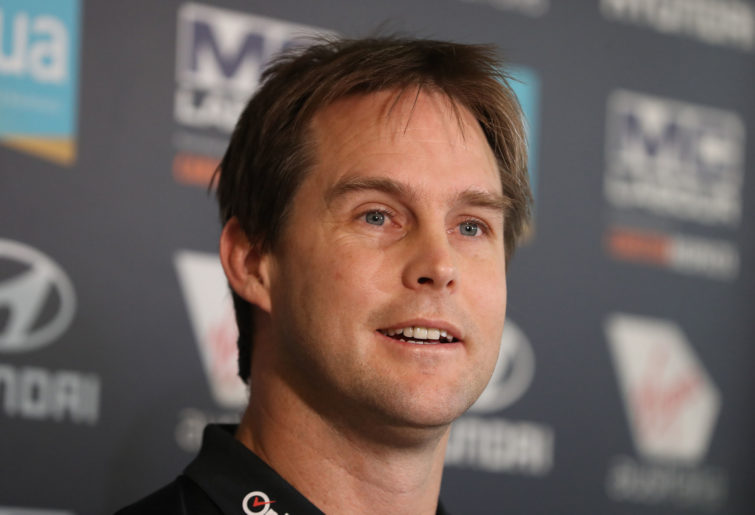
(Photo by Robert Cianflone/Getty Images)
Contract watch
Out of contract
Matthew Cottrell, Josh Deluca, Jarrod Garlett, Patrick Kerr, Kym LeBois, Matthew Lobbe, Andrew Phillips, Angus Schumacher, Kade Simpson.
Pre-agents
Ed Curnow, Marc Murphy, Matthew Kreuzer.
Kade Simpson is the most important player on the out of contract list but by all reports should finalise a deal with the Blues to play in 2020 soon.
You’d want to keep at least one of Andrew Phillips or Matthew Lobbe on the list for ruck depth, presumably Phillips, possibly both.
Next year looms as a big one in terms of trying to manage the departure of veterans over time. It’ll probably be Kade Simpson’s last year and might be time to move on Kreuzer as well, so you’d hope Curnow and Murphy are keen to continue.
Free agency
Simpson and Thomas are free agents at Carlton this year, as is Josh Deluca. Levi Casboult was on this list also but has reportedly achieved a trigger for season 2020.
You’d expect in that case that, other than Thomas maybe finding a new home elsewhere, there won’t be any players leaving the Blues via free agency this offseason, unless perhaps something unexpected emerges with Casboult.
The big news instead for Carlton is their No.1 target this offseason, Stephen Coniglio, last night signed a seven-year deal to remain with the GWS Giants.
Bummer. Coniglio would have been a transformative recruit for Carlton. He’s a top-ten player in the comp and if they got him I’d have argued for them making finals in 2020.
Most importantly, because he was a free agent and because they had a bigger financial offer than GWS, the Blues would have gotten him without giving up a draft pick, which is a genuine heist.
This would have meant paying him a motzah but the Blues could have banked so much of that in the early years of a very front-ended contracted that it wouldn’t have restricted their chance of landing players later on.
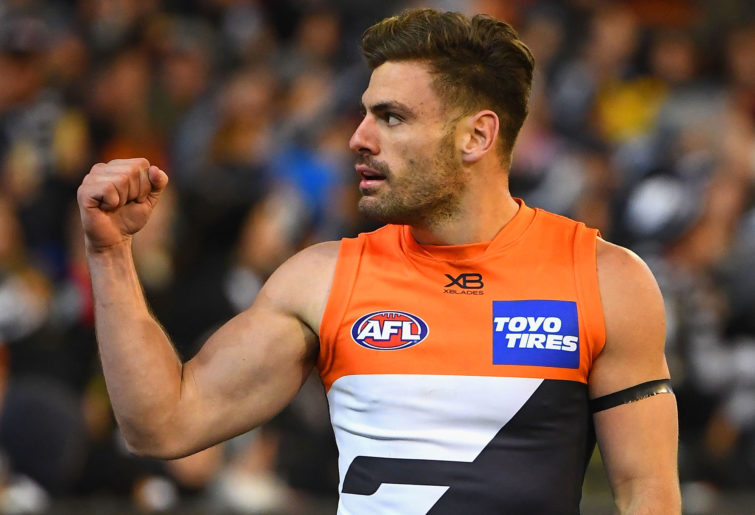
(Photo by Quinn Rooney/Getty Images)
Ah well. It was not to be. As a North Melbourne fan, I find the situation relatable! How often does a top-ten player in the league move from a club playing finals to one in the bottom four? Not very.
If you’re looking for a silver lining it’s that Coniglio’s arrival probably would’ve made it difficult to play both Matt Kennedy and Will Setterfield – or even just one of them – and now they both should have a good opportunity to be regulars in the side.
Could Carlton turn their attention to a different free agent? It’s not the direction they’re reportedly likely to go in, but there is an argument for it.
From my perspective, one of Carlton’s biggest needs is in the ruck – both a senior option who can be relied upon to be fit (unlike Kreuzer), and a quality developing up-and-comer.
For the former, there’s some good options in this year’s free agent pool. Todd Goldstein is the obvious one – he’s had an underrated year and would make a big impact if added to Carlton’s midfield.
Other ideas would be to look at bringing Sam Jacobs back to the club, likely just for a year or two, or to pick up Tom Nicholls from Gold Coast. Nicholls wouldn’t become Carlton’s No.1, but is worth rolling the dice on as mature depth.
Justin Westhoff is another who might be worth considering. He doesn’t play ruck full time but is a valuable player roaming around the ground and could help Carlton maintain a strong veteran presence in the team.
Two others Carlton have been linked to at times are Adam Tomlinson and Brandon Ellis. While both would probably make the best 22 for the Blues and come cheaply, I’d suggest they’re ones to avoid – not because they’re poor players, but I don’t think they move the needle at Carlton.
Tomlinson, in particular, fills a position where Carlton have a lot of young depth.
Trade period
It’s abdundantly clear that Carlton want to get a small forward or two this trade period – over the course of the year they’ve been linked to Jack Martin, Tom Papley, Anthony McDonald-Tipungwuti, Sam Gray, and even former player Eddie Betts.
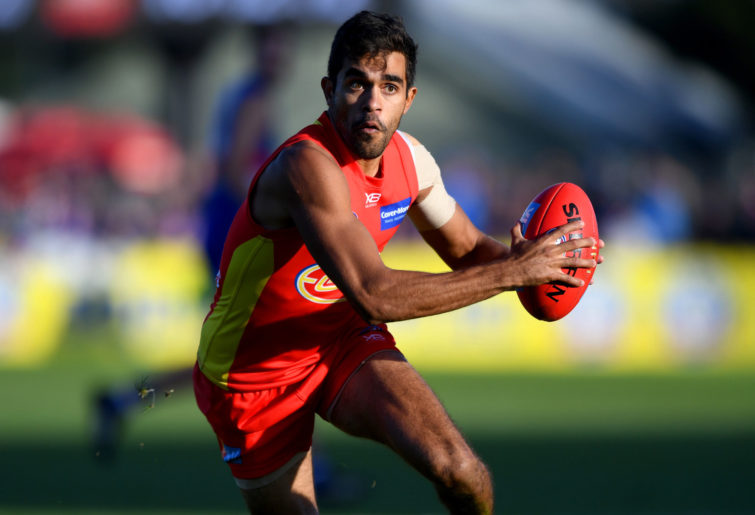
(AAP Image/Joe Castro)
Right now, all the talk is that Martin and Papley are their two preferred options if they can land them. And, now that they’ve missed on Stephen Coniglio, they do perhaps have room to up their financial offer to both players, if they want to.
Neither is a certainty just yet.
Martin is also being pursued by the Western Bulldogs who, despite the Blues’ late-season form, are probably a more attractive destination – but likely to have less cash on offer.
Papley is also being targetted by North Melbourne, who may have an edge in the form of Rhyce Shaw, who has worked with Papley before.
I’d say there’s a strong chance Carlton get at least one of them or quite possibly both. If they miss on at least one, expect them to pick up Sam Gray instead. Despite the links, I’d be surprised if they wound up acquiring McDonald-Tipungwuti or Betts.
The thorny issue with trades, unlike free agency, is that you have to pay something for them – and personally, this is where I become a little sceptical of the merit of recruiting Martin and Papley.
Both Gold Coast and Sydney would be looking for a pick around the early-to-mid teens in return. Carlton currently own pick 8 via the Liam Stocker trade (which, yes, I know you’ve been waiting for it – they won), but don’t have another pick after that till 39.
I’d say a trade strategy to land both looks something like 8 and 39 to Gold Coast for Jack Martin and Brisbane’s first pick, which is currently pikc 17, then look to give that and maybe a future third-round pick to Sydney for Papley. The Swans have some academy prospects next year so that might get it over the line.
That would basically wipe Carlton out of this draft to get those two players, and I’m not sure it’s the right call – but let’s discuss that more later.
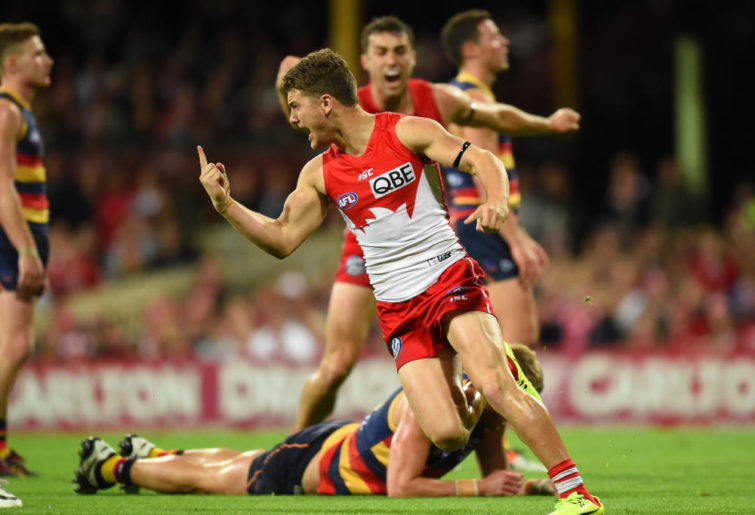
(AAP Image/Dean Lewins)
The other players Carlton have been linked to are Brad Hill and Darcy Cameron.
Hill would probably be a good fit for Carlton, but it’s debatable whether at his age he’s a good fit for their list profile.
I’d say probably not, and that he’d likely cost more than he’s worth to them. It seems more likely that he’ll go to St Kilda, so this probably isn’t one to worry about.
Cameron would be a good acquisition, fitting into my belief that the Blues need a quality developing ruck. He could probably come to the club for a lateish future pick going to Sydney, or in a Papley deal, and might be Carlton’s next No.1 ruckman.
At this stage Cameron appears more likely to join GWS, but ruckman are tricky to predict and if the Giants as expected lure Sam Jacobs to the club, then perhaps Carlton could put it to Cameron that he’s more likely to get games from them next year than he is GWS.
Are there any other players who Carlton should be looking at on the market? Aiden Bonar, Nick Robertson and Harley Bennell are the only other names that jump out to me as being of interest, but I’d be lukewarm on them at best for Carlton.
Ben McKay has obvious romantic appeal, but probably isn’t a good fit.
Draft
Picks inside 30: 8.
It seems unlikely at this stage that Carlton will take pick 8 to the draft. They have flagged from a while out that they intend to trade it for a mature player, and even if they miss on both Jack Martin and Tom Papley they may wind up making an eleventh-hour bid for someone like Brad Hill instead.
Hypothetically though, let’s pretend they go back to the draft. What could they do with this pick?
There’s a few players around the mark who jump out as good options.
Lachie Ash is an exciting half-back with plenty of speed who could be a good fit for Carlton. After two years on the bench there have to be doubts about Sam Docherty’s longevity in the game, and Ash is the kind of player who could work alongside him or replace him if needed.
Brodie Kemp is a really talented and versatile prospect who could be available around this mark. He’s got a big frame – which is rare in this draft – and could wind up playing in the midfield or the forward line, or both, and be a real point of difference wherever he lands.
Sam Flanders at 182cm isn’t necessarily a genuine small forward like what Carlton are looking for, but could play that kind of role or be more on a half-forward flank. Potentially a real weapon for the Blues. Alternatively, Dylan Stephens would be a good fit for them on the wing.
If they want a genuine small forward then Cody Weightman is their man. This is probably too early to pick him but they could look to downgrade pick 8 a little further down the order and get back a later pick or a future pick in return.
However for mine I’d say the number one option for them at this pick would be WA ruckman Luke Jackson. He dominated at the under-18 champs and looks like probably the best under-18 ruckman to come through since Brodie Grundy.
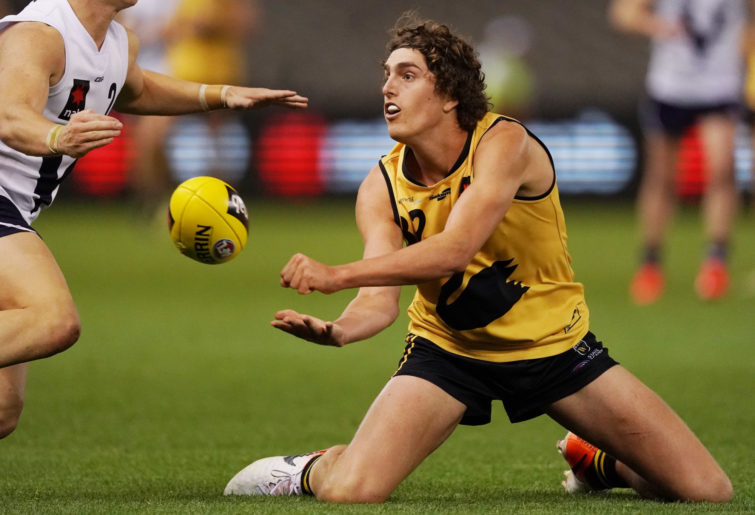
(Photo by Michael Dodge/AFL Photos via Getty Images )
The Blues have drafted plenty of young talent in recent years and for mine the only position on the list that really stands out as a gap is ruck – yes, they’ve got Tom De Koning, but he’s no guarantee to make the grade for them.
Jackson at 198cm is a little undersized for a ruckman, but plays in a way that will mean that probably isn’t too much of a problem. Add him to the list and it really ties Carlton’s future midfield together.
Maybe you feel differently on which player is Carlton’s best fit at this pick – the point is, there’s a lot of options, and they have plenty of appeal.
If the Blues want a small forward with one of their picks later in the draft there’ll be some options. Ned Cahill could be a really good option for them at pick 39 if they still hold it going into the draft.
What I said last year
“Continue to practice the good habits developed over the last three years, and eventually the wheel will turn.
“What’s working in Carlton’s favour is that despite what external critics might say, they’ve got time up their sleeves. They have a patient fan base, and their important young players have largely all committed to the club longterm…
“Carlton aren’t going to become a finals-quality side in the blink of an eye, but if they continue to invest in young talent while doing what they can to build a culture where that talent is challenged and flourishes, they’ll eventually make their way back up the table.”
Outlook
My perspective now is the same as it was a year before, the only difference is that we’re a year closer.
Carlton’s drafting and trading under Stephen Silvagni has, broadly speaking, been pretty good. Silvagni took a slow-burn approach that was always going to take a while to pay off, but I don’t see any reason to worry that it won’t eventually do just that.
The return on investment for them in terms of drafting and trading is about on par – a little below on raw numbers, but probably makes the grade when you consider the specific challenges this club in particular has faced.
If you combine that with the fact Carlton had a proven ability to win when they were the more experienced team by a significant margin this year, and it gives you confidence that when the Blues’ list matures to the point where that happens more often, they’ll win plenty of games.
Like massage-oil soaked towels in the Richmond pool area, if you pile up enough young talent in one place, eventually it will burst into flames.
It’s important to understand that when Silvagni arrived at the club the playing list was pretty barren in terms of youth and prime-age players, and this became even more the case when Silvagni opted to trade out what valuable players did exist in order to prioritise the draft.
That was the right call for Carlton’s longterm future and if you gave me the option of doing it ten times, I would do it ten times again.
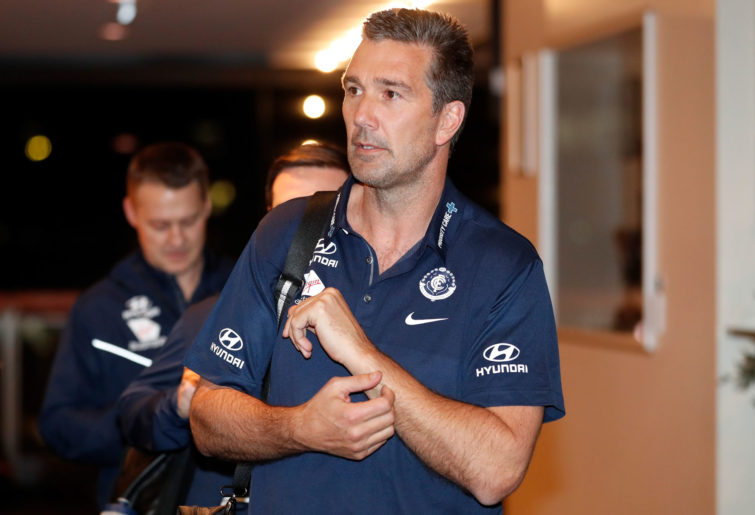
(Photo by Michael Willson/AFL Media/Getty Images)
However, it’s a course of action that meant it was always going to take a while for Carlton to begin moving back up the ladder. Their drafting has been solidly good, but not so exceptional as to buck the laws of list management.
Despite this, it’s my perception that the Blues have become a bit impatient for that rise up the ladder to happen. This was seen in the decision to axe Brendon Bolton halfway through the season, after he achieved just one win in the early part of the year.
David Teague was able to net Carlton six more wins for the year which is exactly what the Blues want, and no one is going to say that winning is bad. However, he did it primarily by putting Carlton’s senior veterans back into more prominent roles in the team.
I’m not saying that’s a bad thing. Bolton’s strategy of making the kids play the most important roles was clearly not working, and now Carlton’s youth can get the chance to develop under a bit less scrutiny and with a bit more positive momentum.
But, that being the case, I would argue it’s a mistake to believe Carlton’s young list is ready to ‘pop’ in the kind of way the Brisbane’s has in 2019. However, I get the impression that many Carlton fans, and probably those in power at the club, feel differently.
If the Blues were landing Coniglio as their equivalent to Brisbane bringing in Lachie Neale, then there’d be a case to feel differently. But they’re not, and while I feel like Jack Martin and Tom Papley coming in would improve the team next year, I’m sceptical that they would do so enough to make it worthwhile.
Carlton need a small forward? There are small forwards in the draft, and the Blues have time enough on their hands to go down that route instead. The draft is historically a better investment than trading, the only reason to trade is if you need impact now. Carlton want it, but they don’t need it.
Selling themselves out of one draft won’t derail Carlton’s rebuild, but trading is like a drug. You experience the euphoria of a quick sugar hit, maybe go so far as to make finals or come within tasting distance of them, and you keep going back for more.
If the Blues go down that path, and wind up putting themselves out of multiple drafts in a row, then five years into the future they’ll be looking for natural improvement to come for the kids they should’ve been drafting right now, and find it’s not there – and we’ll be right back where we started.
Be smart. Be like Han Solo, and know when is the right time to punch the throttle. It’s not just yet.
Thanks to Stats Insider, the AFL Coaches Association, and Draftguru for providing data and tools to make the analysis in this article possible.





























































































